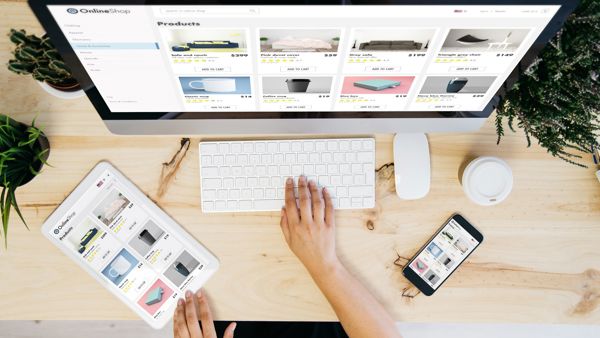Get more insights from HSO Retail Experts


How to optimise your retail operations online and in-store
E-Commerce retailing has grown rapidly in recent years. It surged ahead in the Covid pandemic and then slipped backwards when the pandemic ended. Even so, online volume is significantly higher than it was before the pandemic. The largest part of the gains made during Covid were kept. One benefit of the pandemic was to accelerate the omni-channel aspects of retailing.
What are the biggest challenges in online retail today?
Each of these challenges is an opportunity to improve customer service, grow sales, or reduce costs.
1. Delivery Vs. Click and Collect
Home delivery is always the preferred and only sensible option for big items like cabinet furniture and major electricals. The delivery cost is factored into the price of the item. However, it is difficult to do this if the same item can be seen in stores for less money. Click and collect is often profitable and profitability can be improved by streamlining the operation.
One example is Adidas. If someone orders an item to click and collect, they add the item to the existing quantities on the next appropriate warehouse picking list. They do not pick and pack it separately. When the delivery gets to the store, it is scanned using a mobile device, and the goods receiving person gets an instruction to set one of the items aside in the pickup area, tagged for the customer who is collecting it. This saves packaging and makes it easy to try on clothing and footwear items, helping to minimize returns.
Some omnichannel retailers are also adopting buy online, pick up anywhere. In practice, this means partnerships with other retailers or mall operators, kiosk locations in train stations, etc.
When a consumer comes into a company store to collect an item, staff should be prepared in advance to know what the most likely accessories or add-on sales are likely to be, so they can suggest them in a non-pushy way.
2. Returns
Free returns are expensive, and some retailers are now charging for them. Customers wishing to return something should go online and request a return authorisation. Some retailers like Marks & Spencer now provide returns kiosks in store so that customers do not have to queue at cash register positions to make a return.
When processing returns, be sure to collect a reason code. Customers do not always declare the real reason, but recognising that the information gathered is not perfect, the returns analysis is still helpful.
We mentioned serial returners earlier. The order management team in the E-Commerce Division should get reports on the level of returns by individual shoppers and set a threshold level where the volume of returns is so high that you are happy to block this customer ordering from you ever again. Give these customers to your competitors. Your gain will be their loss.
As your returns section gets more experienced, you can start to identify individual customers and certain sets of circumstances where the return may not be legitimate and then refuse the return authorization and withhold processing a credit.
Some companies, for example, when receiving a return authorisation request for garments, look that person up on Facebook or Instagram to see if they posted a photo wearing the item to a party, wedding, etc. Then they refuse the authorisation.
3. Order Management
A traditional response would be to transfer some of store 7’s stock to store 30 where it can be sold at full price. A new option, courtesy of an omnichannel order management system, is to direct the order management system to fill single item orders for this product from store 7 until store 7’s stock is in line with its up-to-date sales forecast.
The item shipped will be sold at full price. If the cost for the store to mail it to the customer is less than the cost to transfer it to store 1, that will improve contribution. Sometimes, the problem is big enough to do both options at the same time. Give store 30 what you think it can sell and use the order management system to clear the rest. This is one example of how a single view of inventory increases profitability.

4. Online Store Presentation
First, you need to have good customer segmentation and well-developed customer lifestyle portraits using all the customer and sales data related to their interactions with your company online and in-store. Most retailers end up with between 4 and 8 lifestyle portraits.
It’s very complicated and not practical to personalise the website for every individual customer. However, it is easier to personalise it for each customer's lifestyle.
The place to start is the first page after a customer logs in to the site. That is effectively their personal home page. Parts of the page may be common to all pages, such as the welcome back message, but parts could be lifestyle-specific, such as the promotions offered, links to lifestyle-specific product assortments, links to new products and sales relevant to that lifestyle, etc.
The personalisation process can then be developed progressively rather than as one big design project. While doing this, you could review your visual merchandising store practices and see which ones should be followed on the website. For example, if you display fashion in stores, colours should be sequenced from light to bright to dark on a fixture. If you have wide assortments, this might be a good policy to follow in your online web pages.
Smart retailers focus parts of their store display on inspiration. Are their links to inspiration pages on your website, remembering that inspiration is likely to be lifestyle-specific? For example, if you sell garden furniture, barbecues, etc., you will have individual product pages. But should you have a page like the one below?
Product Recommendations
Watch how Dynamics 365 Commerce can be used to show product recommendations on the e-Commerce website and point of sale (POS) device.
Summary
There are many ways to improve online retail performance and only some are touched on here. HSO can help companies get the best from their online experience in many ways, including:
Get more insights from HSO Retail Experts




